foot in mouth: September 2012 Archives
September 26, 2012 9:07 PM
| Permalink
Here is the start of last week's review for the Financial Times of program one:
For what those echoes are and what the current interpreters make of them, please click here for the whole Financial Times review. 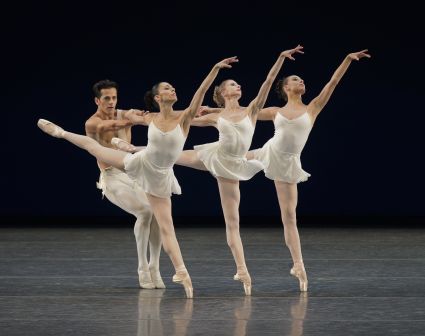 Robert Fairchild reining in his muses: Ana Sophia Scheller as Calliope, Sterling Hyltin as Terpsichore, and Tiler Peck as Polyhymnia. Photo by Paul Kolnik courtesy of the New York City Ballet.
Robert Fairchild reining in his muses: Ana Sophia Scheller as Calliope, Sterling Hyltin as Terpsichore, and Tiler Peck as Polyhymnia. Photo by Paul Kolnik courtesy of the New York City Ballet.
Balanchine once said: "Probably dance would stop if we didn't have Stravinsky." The composer gave him solid foundations on which to build dances, an education in composition, and confidence. In 1972, a year after Stravinsky's death, the New York City Ballet organised a now-legendary festival of a whopping 31 ballets to his scores, including 21 premieres. For the next two weeks, the company presents the cream of that crop: 13 Balanchines, beginning with Apollo, Orpheus and Agon, the only three whose music Stravinsky made to order. Of this "Greek trilogy", Apollo and Orpheus were conceived as a pair, yoked musically and philosophically and also perfect opposites.
The music for the 1928 Apollo is all grand, sunny certitude. Stravinsky's tell-tale pulse may rollick as the young Olympian struggles to rein in his muses, but the music is too sweet to suggest trouble ahead. As for the choreography, the three muses' spiky legs evoke the sun's rays and their circling arms its body. Even as the steps shift between constructivist flatness and sculptural roundness, Apollo's eventual stature as the pillar of well-proportioned art is assured.
Still, he has some growing to do - where would the drama be otherwise? On opening night, Robert Fairchild presented the god evolving beat by beat. He favoured muscular impetus over static line, a brave and unusual choice that gave the performance the edge it lacked last year at his debut in the role.
Orpheus is as saturnine as Apollo is bright, but it has echoes of the earlier work.
 Robert Fairchild reining in his muses: Ana Sophia Scheller as Calliope, Sterling Hyltin as Terpsichore, and Tiler Peck as Polyhymnia. Photo by Paul Kolnik courtesy of the New York City Ballet.
Robert Fairchild reining in his muses: Ana Sophia Scheller as Calliope, Sterling Hyltin as Terpsichore, and Tiler Peck as Polyhymnia. Photo by Paul Kolnik courtesy of the New York City Ballet.
With the Whitney Biennial's embrace of dance for the first time this spring, with commissions to choreographers Sarah Michelson and Michael Clark, and MoMA following suit next month with some sweet day, a curated series of postmodern premieres, it's fitting that fall began with works that also merged the disciplines.
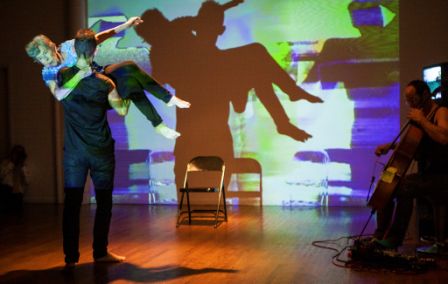 Jason Akira Somma and Frances Wessells with musician-composer Chris Lancaster. Photo: David Phelps
Jason Akira Somma and Frances Wessells with musician-composer Chris Lancaster. Photo: David Phelps
No matter the style, dance involves a paradox: the body's vital solidity against the dancing's ephemerality. Jason Akira Somma's keenly promising Phosphene Variations deploys vaporous films and hallucinatory screen versions of live dancers to home in on this anomaly.
Enclosed in a palm reader's black curtains - though here they are only cordoning off a section of the interdisciplinary SoHo gallery Location One - a holographic Baryshnikov warps and wobbles on a stream of vapour. With every bend in the projector's misty light, his white shirt and beige slacks striate into bars of brown and grey. When you dip your hand into the airstream, he devolves into a muddy swirl, out of which another luminary emerges, such as Ailey alum Carmen DeLavallade or Somma's mentor (under Rolex's arts mentoring scheme) Jirí Kylián.
We do not need to recognise the artist, however, for these 3D figures to prompt a shiver of dread. Baryshnikov's belovedness and his greying may intensify intimations of mortality, but the film's ghostly silence and the cloud by which we see it would arouse such sentiments for anyone. The holograph comes so close to simulating life that you feel the gap.
The ensuing show in Location One's theatre (each week a rotating cast of local performers improvises with their trippy live screen version) might have strayed from this sombre theme - have been a loose end - if not for Frances Wessells. She is 93. The founder of Virginia Commonwealth University's adventurous dance department, Wessells began seated. On four variously sized video screens, Somma multiplied and stacked her silhouette, outlined in fluorescent hues, until it filled a whole virtual theatre, as if all her selves were watching a movie of her years slide by.
Eventually Somma - lanky, muscular and 32 - handed his camera to a colleague and joined Wessells. Imagine a panther cavorting with a dandelion.
 Jason Akira Somma and Frances Wessells with musician-composer Chris Lancaster. Photo: David Phelps
Jason Akira Somma and Frances Wessells with musician-composer Chris Lancaster. Photo: David Phelps For more on this charged encounter, click for the full Financial Times review. (If you hit a registration wall, you only have to register, free, once for eight free articles a month on the website.)
Jonah Bokaer's collaboration with light-installation artist Anthony McCall, which introduced BAM's new space, also took up the time-space continuum: the sheer physics of it. Here are two paragraphs from the middle of my Financial Times review of their Eclipse:
Eclipse is perfect for inaugurating BAM's handsome, $50m, 250-seat Fishman Space for experimental work, around the corner from the opera house. Taking full advantage of the flexible seating, Bokaer has the audience frame the dancers both at ground and balcony level. McCall's tilted grid of 36 hanging light bulbs also calls attention to dimension and perspective. The piece's drama is largely spatial: the romance of volume and plane. At the hour's cosmic start, all the Mars-red bulbs blazing at once seemed to emanate from a distant point.
Everyone but the choreographer. Photo by Stephanie Berger
The dancers brought the astral plane down to earth, beginning with Bokaer, who palmed one globe, then another, and kneeled to enfold a nimbus of light in a muscular embrace - an odd and poignant gesture. The other four (the excellent Tal Adler-Arieli, CC Chang, Sara Procopio and Adam Weinert) left the bulbs alone to translate space into time. If objects appear closer together the farther away they are from us, movement - time embodied - seems to slow as it recedes. So the dancers on the perimeter progressed through chunky patterns at zombie speed and orbited tightly around themselves while a gravity-driven loner reversed his path repeatedly as he slipped and slid, lunged, turned and flailed. Eventually someone else assumed his role and he gravitated to the margins.
For this Einsteinian experiment's emotional residue, click for the whole Financial Times review.
September 16, 2012 9:56 PM
| Permalink
The Bollywood dances combined bouncy Indian folk rhythms with the veils, bare bellies, voluptuous arms and "come hither" glances of a hedonistic east borrowed from 1950s Hollywood, of all things. In a perfect Duck Soup update, the Mayuri Group we were watching hails from Russia, whose enthusiasm for Bollywood reaches back to the Cold War, when India supplied the Soviets with extra musicals. In one solo to the swinging 1958 ditty "Mera Naam Chin Chin Chu", Natalia Fridman swished and galloped and batted her eyes more like Betty Boop than like your average avenging Hindu goddess.
For that we had the splendid Kuchipudi dancer-actor Padmavani Mosalikanti as the vanquishing deity Durga. As the buffalo demon Mahishasura, her husband Jaikishore let down his guard: what could a mere woman do to him who had terrorised the universe? She knocked him to the floor and stabbed him with the trident of her three fingers as her eyes crossed with conquering fury. He gnashed his teeth and rolled his eyes in agony. It was glorious.
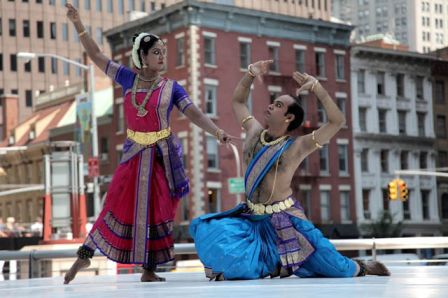
Photo by Darial Sneed
Having completed the task for which she was supernaturally born - through the combined powers of Brahma, Shiva and Vishnu - this Durga folded one leg atop the other as if sitting on air and gazed out serenely like a statue in a shrine.
People's choice- -at the ballet? If it were up to the audience, what would a ballet season be?
September 10, 2012 10:30 PM
| Permalink
From my Financial Times review of the Smuin Ballet, at the Joyce a month ago:
Trey McIntyre, whose own troupe is now the toast of Boise, has finally found a form for his whimsical, wide open, very American imagination. Taking its title and music from the Portland band The Shins, Oh, Inverted World is ballet's answer to indie rock - The Shins' kind, in which sweet, strummed melodies support vivid, ruminative lyrics. The dance imagines introspection as a way of being with others: a loose, unmannered communality.
Shrugs, shakes, and pops punctuate the movement as jangle and pluck do the melodies. These casual eruptions set off chain reactions through the body, the cluster of dancers, even the dance's various sections, which McIntyre has strung together with unforced ingenuity.
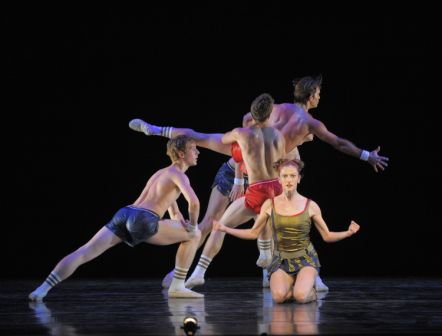 Jane Rehm and other members of the Smuin Ballet in Oh, Inverted World. Photographer: David Allen.
Jane Rehm and other members of the Smuin Ballet in Oh, Inverted World. Photographer: David Allen. The McIntyre was the highlight of the Smuin Ballet's mishmash of a program last month (for the full Financial Times report, click here). In fact, those who were happy with McIntyre's slouchy low-key world were likely to hate the slick histrionics of Smuin's own Medea--and that neatly summarizes the problem American ballet as a whole faces.
Smuin's schlock keeps the company solvent but also dooms it to artistic irrelevance; American classical companies make a similar bargain with the 19th-century or at least full length story ballet. The bulk of the national audience equates ballet with story ballet--and wants to see what they already know. The powers that be lack the funds and/or the guts not to give it to them. No one is being brave or, if you like, reckless enough.
For a sample taste--a very bitter taste--of the audience to which ballet companies just may be catering, I suggest you read the reader comments to Alastair Macaulay's nuanced essay on the racial politics of too many Imperial ballets: Le Corsair, Raymonda, etc. (I don't agree with Macaulay's every point, but many. He argues carefully for the most part. I discuss similar issues in a 2005 essay for Newsday, "The Exotic Ballet," on the occasion of the Bolshoi's reconstruction of Petipa's The Pharaoh's Daughter. There's no free link to the article on the Newsday site, but it was pasted into this Russian ballet forum. Scroll down to after the photo from Don Q. I return to the issue near the end of this Foot post, here, about a year later.)
Macaulay's responders combine vitriol with blockheadedness. One commenter argues in favor of the stupid and evil Muslim characters in Raymonda and Le Corsair because stereotypes, he says, are basically accurate. (They may have removed that comment...I couldn't find it this time.)
Other people cling to the notion of authenticity despite Macaulay pointing out that there is no extant original to adhere to--and this lack of anchor seems only to have made the caricatures more offensive, not less.
The commenters accuse him of the equivalent of book-burning and of "political correctness". Why is it that one is only guilty of "political correctness" when one is correcting for reactionary values? How about those who "correct" for liberality--you know, demand we favor the fetus over the mother in cases of rape. (See: the current Republican Party.)
It would be bad enough if the heads of ballet were organizing their seasons around know-nothings, but around bigots as well?
Is experimental dance already too far out to have any use for the Fringe?
September 1, 2012 11:52 PM
| Permalink
Here, in excerpts from my Financial Times roundup of August 13, some of the reasons why, as well as some of the saving graces. (As you can see from the comment from Asylum's director--that is, you can see if you click-- not everyone agrees with my dour judgement. Confidential to Bobby Miga: I have nothing against paper-mache. The baby heads were a high point.)
.....
Asylum, by the Nashville troupe Uprock, promised hilarious tastelessness - a perennial Fringe attraction - which its less-than-amateur execution delivered intermittently. Between extended pauses in which the brave dancers engaged in vague shadow play behind upturned hospital cots, the hip-hop ballet offered before and after scenes. The vulnerable characters first appeared on the street, where the damage was done, then in the ward, where they relived their trauma in hallucinations.
In one suitably outrageous number, a young mother whose baby had been catapulted out of her arms by the homeless driver of a shopping cart engaged in a pas de trois with hospital orderlies wearing huge papier-mâché bald-baby heads. In another, a janitor's coughing fit transmogrified into a hip-hop beat for an asylum boogie.
Also typically Fringe was the monomania behind former Stomp star Yako Miyamoto's Cobu. Mining the theatrical and choreographic possibilities of women banging on big drums, her seven-member troupe seemed half-witch, half samurai, in their yoking of martial exactitude and demonic energy. They leapt into the air to thwack the cauldron-shaped taiko drums with thick sticks and dashed from drum to drum in myriad geometries.
Unlike the Uprockers, Miyamoto put on a tight show, with colourful costume additions - long vests, samurai pantaloons, sequined midriff wraps - designating separate numbers. But there is a reason taiko favours short sets. An hour and a half of drumming, no matter what the accessory thrills, is too much....
The Covent Ballet Theatre of Brooklyn may have given off a whiff of school recital on opening night, with so many of the performers' families in the house, but bringing to story ballet the social conscience of modern dance circa the 1920s and '30s suits the combo-crazy Fringe. A historical fiction of a ballet, Orphan Train was inspired by the thousands of New York urchins sent west from 1853 until 1929 to be adopted by farm families.
Some of the wonderful children of Orphan Train. Photo by Barry Yanowitz courtesy of the NY Fringe.
Choreographer Marla Hirokawa made excellent use of the mix of children and adults in patterns that were simple without ever being dull and that cleanly telegraphed mood. Her libretto, however, gave me pause. Many fairytales risk the hero's life and many more subject a motherless child to wicked witches and stepmothers, but how many have the good child himself die - only to replace him cheerfully with another child? The little boy in my row who had been peppering his father with questions on murky plot points was dumbstruck by that one.
Still more deserving of a "What were they thinking?" award...
The one gap that the New York Fringe does fill in the local scene is of intimate world dance idioms such as flamenco and classical Indian. The best show I saw--by a long shot: it was extraordinary, title notwithstanding--was Malini Srinivasan's Being Becoming. This tells us something about the biases of New York presenters.
The Joyce has been presenting more flamenco and Indian classical in the last few years, and the World Music Institute has always showcased these foreign forms. But the smaller theatres have nothing to do with them. The one exception is tap, our flamenco. The result is that unless you are world-acclaimed, and can sell out City Center, you hardly have an audience at all. There is no in between.
Presenters at spaces such as New York Live Arts, The Kitchen, Danspace, PS 122, the Baryshnikov Arts Center, etc. need to ask themselves whether they are interested in dance experimentation per se or only within the modern dance tradition. The conclusion I hope they come to is that of the literary world re "genre" fiction (the mystery, the detective, the romance, the historical novel, etc)--that its supposed opposite, the minimalist, realist story where nothing much happens, given pride of place since the 1960s, belongs to a genre, too. The fact that we don't see it as such only proves that genre's dominance.
Similarly, if Indian classical dance seems more tradition-bound than postmodern dance, it is only because we don't know the tradition. In the idiom's foreignness, the fact of its formulas--if not what they are and when they are subverted--stands out.
AJ Blogs
AJBlogCentral | rssculture
About Last Night
Terry Teachout on the arts in New York City
Terry Teachout on the arts in New York City
Artful Manager
Andrew Taylor on the business of arts & culture
Andrew Taylor on the business of arts & culture
blog riley
rock culture approximately
rock culture approximately
critical difference
Laura Collins-Hughes on arts, culture and coverage
Laura Collins-Hughes on arts, culture and coverage
Dewey21C
Richard Kessler on arts education
Richard Kessler on arts education
diacritical
Douglas McLennan's blog
Douglas McLennan's blog
Dog Days
Dalouge Smith advocates for the Arts
Dalouge Smith advocates for the Arts
Flyover
Art from the American Outback
Art from the American Outback
lies like truth
Chloe Veltman on how culture will save the world
Chloe Veltman on how culture will save the world
Life's a Pitch
For immediate release: the arts are marketable
For immediate release: the arts are marketable
Mind the Gap
No genre is the new genre
No genre is the new genre
Performance Monkey
David Jays on theatre and dance
David Jays on theatre and dance
Plain English
Paul Levy measures the Angles
Paul Levy measures the Angles
Real Clear Arts
Judith H. Dobrzynski on Culture
Judith H. Dobrzynski on Culture
Rockwell Matters
John Rockwell on the arts
John Rockwell on the arts
State of the Art
innovations and impediments in not-for-profit arts
innovations and impediments in not-for-profit arts
Straight Up |
Jan Herman - arts, media & culture with 'tude
Jan Herman - arts, media & culture with 'tude
dance
Foot in Mouth
Apollinaire Scherr talks about dance
Apollinaire Scherr talks about dance
Seeing Things
Tobi Tobias on dance et al...
Tobi Tobias on dance et al...
jazz
Jazz Beyond Jazz
Howard Mandel's freelance Urban Improvisation
Howard Mandel's freelance Urban Improvisation
ListenGood
Focus on New Orleans. Jazz and Other Sounds
Focus on New Orleans. Jazz and Other Sounds
Rifftides
Doug Ramsey on Jazz and other matters...
Doug Ramsey on Jazz and other matters...
media
Out There
Jeff Weinstein's Cultural Mixology
Jeff Weinstein's Cultural Mixology
Serious Popcorn
Martha Bayles on Film...
Martha Bayles on Film...
classical music
Creative Destruction
Fresh ideas on building arts communities
Fresh ideas on building arts communities
The Future of Classical Music?
Greg Sandow performs a book-in-progress
Greg Sandow performs a book-in-progress
Overflow
Harvey Sachs on music, and various digressions
Harvey Sachs on music, and various digressions
PianoMorphosis
Bruce Brubaker on all things Piano
Bruce Brubaker on all things Piano
PostClassic
Kyle Gann on music after the fact
Kyle Gann on music after the fact
Sandow
Greg Sandow on the future of Classical Music
Greg Sandow on the future of Classical Music
Slipped Disc
Norman Lebrecht on Shifting Sound Worlds
Norman Lebrecht on Shifting Sound Worlds
The Unanswered Question
Joe Horowitz on music
Joe Horowitz on music
publishing
book/daddy
Jerome Weeks on Books
Jerome Weeks on Books
Quick Study
Scott McLemee on books, ideas & trash-culture ephemera
Scott McLemee on books, ideas & trash-culture ephemera
theatre
Drama Queen
Wendy Rosenfield: covering drama, onstage and off
Wendy Rosenfield: covering drama, onstage and off
visual
Aesthetic Grounds
Public Art, Public Space
Public Art, Public Space
Another Bouncing Ball
Regina Hackett takes her Art To Go
Regina Hackett takes her Art To Go
Artopia
John Perreault's art diary
John Perreault's art diary
CultureGrrl
Lee Rosenbaum's Cultural Commentary
Lee Rosenbaum's Cultural Commentary
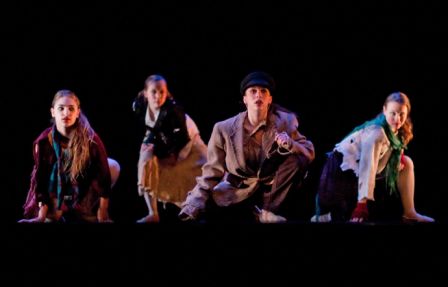

Recent Comments